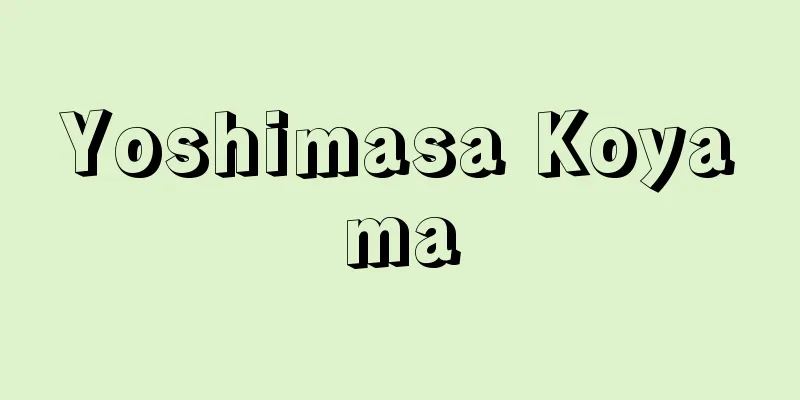Kitakyushu Industrial Area

|
An industrial zone that stretches from the Kanmon Straits to the depths of Dokai Bay in the northeastern part of Fukuoka Prefecture, stretching about 30 kilometers east to west along the coast of Kitakyushu City. Its area is sometimes defined as being centered on Kitakyushu City, and extending from Fukuoka City, Kurume City, and Omuta City to the western part of Yamaguchi Prefecture, or as covering the entire northern Kyushu region, but the most common and narrowest definition is that it is limited to the area of Kitakyushu City. The location was most favorable due to the presence of the Chikuho coalfields, and the construction of the government-run Yawata Steel Works (now Nippon Steel & Sumitomo Metal) using coal from the Chikuho coalfields and iron ore from mainland China made it an advantageous location for various factories thereafter. However, the decline of the Chikuho coalfields and the bias towards materials industries have made it less favorable for new factory locations in recent years, and its status as an industrial area has declined. Looking at the process of its establishment, the beginnings were the full-scale development of the Chikuho coalfields in the mid-Meiji period and the construction of the ports of Moji and Wakamatsu as coal transport ports. After that, the government-run Yawata Steel Works began operations in 1901 (Meiji 34) based on the policy of self-sufficiency in steel after the Sino-Japanese War, and full-scale industrialization began to progress. As the steelworks continued to expand, related factories that were directly connected to the steelworks and focused on the production of capital goods such as firebricks, coke, chemicals, steel, and cement, as well as machinery and electrical equipment industries for coal mines and consumer goods industries such as food and lumber also developed, and the outline of the industrial zone was completed around the time of World War I, and it established its position as one of the four major industrial zones. It was hit hard by World War II, but recovered with the Korean War as a turning point, mainly in the steel industry, and has continued to do so to this day. This industrial zone is characterised by its predominance of heavy chemical and material-based industries, with steel at its centre, and because these were developed around specific large factories funded by state and central capital, the growth of locally-funded companies was delayed, making it more of a supply base for raw materials to developed industrial zones. This characteristic is clear from the fact that the majority of Kitakyushu's manufacturing shipments are accounted for by just a few companies, including Nippon Steel Sumitomo Metal, Mitsubishi Chemical (now Mitsubishi Chemical) and Nippon Steel Sumitomo Metal Chemical. Looking at the state of industry in Kitakyushu in 2006 (Heisei 18), there were 1,172 factories, 50,140 employees and a manufacturing shipment value of 1,841.3 billion yen, accounting for 0.6% of the national shipment value. The breakdown of this is as follows: iron and steel industry accounted for 6.0% of the number of factories, 16.3% of the number of employees, and 40.2% of the value of manufactured goods shipped, followed by the chemical industry at 3.4%, 5.8%, and 11.2%, and general machinery industry at 14.2%, 13.8%, and 11.7%, indicating that heavy chemical industries have a high proportion and that there are many large companies. Looking at the shipping value of Fukuoka prefecture to see the industrial area's position in the nation, in 1935 (Showa 10) it accounted for 8.2% of the national shipping value, but after World War II, its share declined to 5.6% in 1950 (Showa 25) and 2.6% in 2006, and Kitakyushu city's share of Fukuoka prefecture's shipping value has also declined to 23.7%. This is due to the decline of the Chikuho coalfields due to the energy revolution, the cessation of trade with China, the slump in the processing-type machinery industry due to an overemphasis on material-type industries, and the deterioration of industrial infrastructure such as land, water, and transportation. One of the purposes of the merger of the five cities that took place in 1963 was to resolve this stagnation in the industrial area. To improve the industrial infrastructure, 508 hectares of Shinmoji waterfront industrial land on the Suo-Nada side and 1,387 hectares of Hibikinada waterfront industrial land have been reclaimed, but there has been little progress in attracting new companies. In the past, air pollution was worsening, especially along the coast of Dokai Bay, leading to many asthma sufferers, and Dokai Bay's water quality was so bad that it was called the "Sea of Death." Other pollution problems, such as noise, vibration, and foul odors, were also severe, but preventive measures have been implemented in recent years and improvements have been made. Looking at the distribution of major factories, they are concentrated in the waterfront areas, with many of the factories of large companies located in Moji Ward, such as Nikka Whisky and Kanmon Sugar, Toshiba, TOTO, and Nippon Steel Sumitomo Metal Kokura in Kokurakita Ward, Nippon Steel Sumitomo Metal, Nippon Steel Sumikin Chemical, Nippon Suisan, and Asahi Glass in Tobata Ward, Nippon Steel Sumitomo Metal in Yahatahigashi Ward, Mitsubishi Chemical, Yaskawa Electric, Mitsubishi Materials, Kurosaki Harima in Yahatahigashi Ward, and Hitachi Metals Wakamatsu in Wakamatsu Ward. [Masaaki Ishiguro] [References] | | |Source: Shogakukan Encyclopedia Nipponica About Encyclopedia Nipponica Information | Legend |
|
福岡県北東部、関門海峡から洞海湾(どうかいわん)の奥にかけて東西約30キロメートルにわたり北九州市臨海部に広がる工業地帯。その範域については北九州市を中心に、福岡市、久留米(くるめ)市、大牟田(おおむた)市から山口県西部まで拡大したり、北部九州全域をあてる場合もあるが、北九州市の範域に限定するのがもっとも一般的かつ狭義の定義である。 その立地条件としては筑豊炭田(ちくほうたんでん)の存在がもっとも大きく、その石炭と中国大陸の鉄鉱石を利用して官営八幡製鉄所(やはたせいてつじょ)(現、新日鉄住金)が建設されたことが、その後の諸工場立地の有利な条件となった。しかし、筑豊炭田の衰退、素材工業への偏りが、近年では新しい工場立地にとって有利とはいえず、工業地帯としての地位は低下している。 成立過程をみると、明治中期の筑豊炭田の本格的開発と、石炭輸送港である門司(もじ)・若松(わかまつ)両港の整備とがその発端となった。その後、日清(にっしん)戦争後の鉄鋼自給政策に基づく官営八幡製鉄所が1901年(明治34)操業を開始してから本格的な工業化が進展し始めた。製鉄所の相次ぐ拡張に伴い、製鉄所に直結した耐火れんが・コークス・化学・鉄鋼・セメントなどの生産財生産を中心とした関連工場や、炭鉱向けの機械・電気機器工業、さらには食料品・木材などの消費財工業も発達し、第一次世界大戦ごろには工業地帯の輪郭が完成、四大工業地帯の一つとしての地位を築いた。第二次世界大戦により大きな打撃を受けたが、鉄鋼業を中心に朝鮮戦争を機に復興を遂げて現在に至っている。 本工業地帯の特徴は、鉄鋼業を中心とする素材型の重化学工業が卓越していることで、しかもそれらが国家や中央資本の投下による特定大工場を中心に展開されたため、地元資本による企業の成長が遅れ、先進工業地帯に対する原料素材の供給基地的性格が強い。北九州市の製造品出荷額の過半が、新日鉄住金、三菱(みつびし)化学(現、三菱ケミカル)、新日鉄住金化学など数社によって占められていることからもその特徴がよくわかる。2006年(平成18)における北九州市工業の状況をみると、工場数1172工場、従業者数5万0140人、製造品出荷額1兆8413億円で、全国出荷額の0.6%を占める。その内訳は、鉄鋼業が工場数で6.0%、従業者数で16.3%、製造品出荷額で40.2%となり、以下化学工業がそれぞれ3.4%、5.8%、11.2%、一般機械工業が14.2%、13.8%、11.7%と、重化学工業の比重が高く、かつ大企業の多いことが示される。 本工業地帯の全国における位置づけをみるために福岡県の出荷額をみてみると、1935年(昭和10)には全国出荷額の8.2%を占めていたが、第二次世界大戦後その比重は低下し、1950年(昭和25)に5.6%、2006年には2.6%となり、福岡県出荷額に占める北九州市の比重も23.7%と低下してきた。これは、エネルギー革命によって筑豊炭田が衰退したこと、中国貿易の途絶、素材型工業への偏重のために加工型の機械工業が不振であったこと、用地・用水・輸送などの産業基盤が悪化したことなどが原因である。1963年に実現した5市合併も、このような工業地帯の停滞を解消することが目的の一つであった。 産業基盤整備のために周防灘(すおうなだ)側の新門司臨海工業用地508ヘクタールと、響灘(ひびきなだ)臨海工業用地1387ヘクタールが埋め立てられたが、新規企業の立地はさほど進んでいない。なお従来洞海湾沿岸を中心に大気汚染が進み喘息(ぜんそく)患者が多く、洞海湾も「死の海」といわれるほど水質汚濁が著しかった。そのほか騒音、振動、悪臭などの公害が激しかったが、近年では防止対策が行われ、改善が進行してきた。主要工場の分布をみると、臨海部に集中し門司区にはニッカウヰスキー、関門製糖、小倉北区には東芝、TOTO、新日鉄住金小倉、戸畑区には新日鉄住金、新日鉄住金化学、日本水産、旭硝子(あさひガラス)、八幡東区には新日鉄住金、八幡西区には三菱ケミカル、安川電機、三菱マテリアル、黒崎播磨(はりま)、若松区には日立金属若松などの大企業の工場が多数立地している。 [石黒正紀] [参照項目] | | |出典 小学館 日本大百科全書(ニッポニカ)日本大百科全書(ニッポニカ)について 情報 | 凡例 |
>>: Kitakyushu [city] - Kitakyushu
Recommend
Profit - Rieki
〘noun〙① Something gained. To gain. A share of prof...
Crawford, AC
...Dalloss P. et al., 1982) have generally accept...
Modern armor - Touseigusoku
A style of Japanese armor used in the early moder...
Lerdo de Tejada, M.
…A decree drafted and enacted in 1856 by Mexico&#...
Igapo Forest - Igapo-rin
... The typical vegetation of Amazonia is forest....
Horticulture - horticulture
Intensive agriculture cultivates vegetables, fruit...
Shadow play - Kageshibai
It is a performing art in which flat puppets, ani...
Open disk
…To make a clear distinction, the circle defined ...
Pelton, LA (English spelling) PeltonLA
...They are used when the difference in height (c...
Mie
A term used in Kabuki acting and directing. Durin...
Steam coal - Ippantan
Coal used as general fuel. In the past, it was wid...
Acanthaceae - Red
…A compound-leaved tree of the Acanthaceae family...
Kwos - Kwos
...When the priest runs between the opposing grou...
British American Tobacco Co.
…Its official name is the British American Tobacc...
Willis system shorthand
...the activity of listening to a speech, talk, e...


![Cantabria [Mountain Range] (English spelling) Cordillera Cantábrica](/upload/images/67cb4ae851d72.webp)






